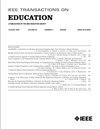新冠肺炎疫情期间少数民族服务机构学生工程文化的培养
IF 2
2区 工程技术
Q2 EDUCATION, SCIENTIFIC DISCIPLINES
引用次数: 0
摘要
工程的文化适应是指新手学习和内化工程专业的内容、实践和价值观的过程。本研究采用融合了内在和外在影响的文化适应模型。外部影响来自制度框架,特别是ABET制定的第一年课程标准。该研究旨在通过2022年春季对两所美国少数族裔服务机构的626名学生进行的调查来实施和测试这一模型。该研究解决了四个问题:1)不同院校学生的文化适应程度有何不同?2)适应与新冠疫情的影响有何关系?3)在西班牙裔服务机构(HSI)中,这些维度如何根据第一代身份和种族/民族而变化?4)探索性因素分析如何表征文化适应,它与自我效能感有何关系?研究结果表明,随着学生在课程中的进步,他们的文化适应程度普遍会提高,尽管在人口统计学和机构之间存在差异。COVID-19对两个维度产生了重大影响,其影响因机构而异。第一代和少数族裔学生也有类似的趋势,与大多数同龄人相比,他们往往表现出劣势。最后,因子分析证实了文化适应和自我效能是不同的构式。这些有希望的结果证明,文化适应模式可能有助于在多个工程领域吸引和留住学生。研究结果对研究和实践也有广泛的影响,特别是在涉及弱势少数民族学生时。本文章由计算机程序翻译,如有差异,请以英文原文为准。
Enculturation of Students Into Engineering During COVID-19 in Minority Serving Institutions
Enculturation into engineering refers to the process by which novices learn and internalize the content, practices, and values of the engineering profession. This study employs an enculturation model incorporating both intrinsic and extrinsic influences. Extrinsic influences stem from institutional frameworks, particularly first-year curricular standards set by ABET. The study aimed to operationalize and test this model through a survey conducted during the Spring 2022 with 626 students at two U.S. minority-serving institutions. The research addressed four questions: 1) How do enculturation dimensions vary across student classifications at each institution? 2) What is the relationship between enculturation and the impact of COVID-19? 3) How do these dimensions vary based on First-Generation Status and Race/Ethnicity at a Hispanic-Serving Institution (HSI)? 4) How does Exploratory Factor Analysis characterize enculturation, and how does it relate to self-efficacy? Findings indicate that students generally increase in enculturation dimensions as they advance in their programs, though differences exist across demographics and institutions. COVID-19 significantly impacted two dimensions, with effects varying by institution. First-Generation and minority students followed similar trends, often demonstrating disadvantage compared to majority peers. Finally, factor analyzes confirmed that enculturation and self-efficacy are distinct constructs. These promising results provide proof that the model of enculturation can potentially help attract and retain students in multiple engineering fields. The results also have wide implications for research and practice, specifically when pertaining to disadvantaged minority students.
求助全文
通过发布文献求助,成功后即可免费获取论文全文。
去求助
来源期刊

IEEE Transactions on Education
工程技术-工程:电子与电气
CiteScore
5.80
自引率
7.70%
发文量
90
审稿时长
1 months
期刊介绍:
The IEEE Transactions on Education (ToE) publishes significant and original scholarly contributions to education in electrical and electronics engineering, computer engineering, computer science, and other fields within the scope of interest of IEEE. Contributions must address discovery, integration, and/or application of knowledge in education in these fields. Articles must support contributions and assertions with compelling evidence and provide explicit, transparent descriptions of the processes through which the evidence is collected, analyzed, and interpreted. While characteristics of compelling evidence cannot be described to address every conceivable situation, generally assessment of the work being reported must go beyond student self-report and attitudinal data.
 求助内容:
求助内容: 应助结果提醒方式:
应助结果提醒方式:


